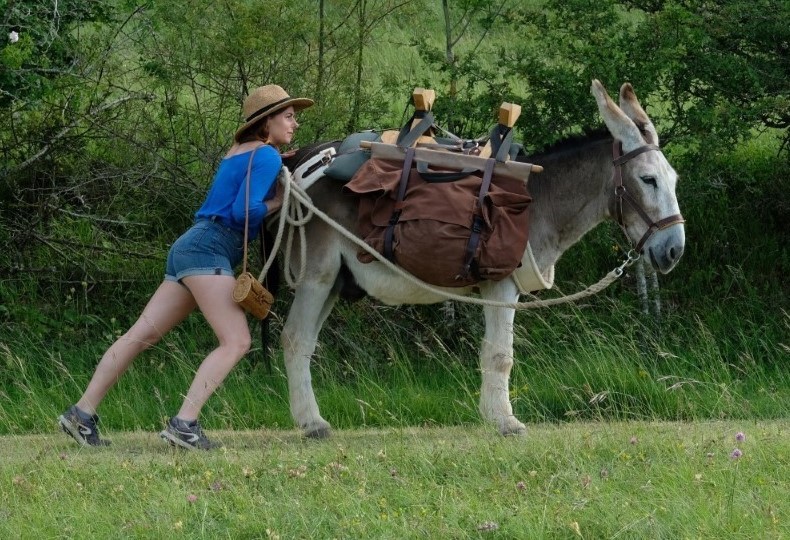“Oh! Journeys, which
ripen our hearts and open us to happiness,” wrote Raymond Lévesque in Les
Voyages, a magnificent song immortalized by French singer Barbara.
اضافة اعلان
This is the
experience that awaits heroine Antoinette in the bittersweet romantic comedy My
Donkey, My Lover & I by
Caroline Vignal, which is being screened today at
the 34th edition of the European film festival at Haya Cultural Center in
Amman. Through the course of the film, the woman will come a long way — both
literally and figuratively — during an unplanned adventure across the
mountains.

This unpretentious
film was a great success in France last fall, earning its star Laure Calamy a
César for best actress — a well-deserved award. (Calamy first made a name for
herself playing Noémie, a bubbly secretary, in the series Ten Percent, “Dix
Pour Cent” in French.)
An unlikely romance
Antoinette is a single teacher who has a clandestine relationship with
the father of one of her students. The film begins when she and her primary
class perform the song Véronique Sanson: In love! for the students’ parents.
The tone is set: Antoinette is a free woman, more attentive to the palpitations
of her heart than to the morals of others.
For months,
Antoinette has been waiting for summer and the promise of a romantic week away
with her lover,
Vladimir. So when he cancels their holiday to trek through the
Cévennes with his wife and daughter, Antoinette does not hesitate; she
impulsively heads south to follow in his footsteps. Little does she know as she
sets out on her journey that her appearance will change along the way, and she
will become attached to a most unlikely companion: the donkey carrying her
belongings.
Antoinette’s only
companion on this singular trip is Patrick, a recalcitrant donkey, so do not
expect to hear much dialogue in Vignal’s latest feature film. Nevertheless, you
will not be bored. Most of the speech is based on monologues admirably well
interpreted by the main actress (Ten Percent, 2015-2020; Only Animals, 2019) as
she traverses the picturesque French mountain range.

My Donkey, My
Lover & I could be described as a story of friendship or even love, tinged
with romance. Friends support each other, protect each other, and do everything
to carry each other as far as possible. As abstract as it may seem, this is the
case between Antoinette and her donkey, Patrick. Even if the insinuations lack
subtlety in the staging, it is pleasant to see a romantic comedy reinvented.
The film takes on
the codes of this cinematic genre: the two protagonists start out distant, and
as things progress, they grow closer and realize that each contributes to the
other’s personality and life. Sometimes vaudeville, sometimes romantic film,
the balance is very intricately manufactured to allow for a pleasant and fluid
experience.
The most beautiful landscape
Vignal’s second film, 20 years in the wake of her first (The Other
Girls, 2000), My Donkey, My Lover & I is inspired by
Robert Louis Stevenson’s diary, Travels with a Donkey in the Cevennes. The famous Scottish
author and adventurer had once followed this same route to the south, also in
search of a remedy for heartache. The idea that “we are all travelers in this
world in search of happiness” pervades the atmosphere.
At times, the film
is reminiscent of Éric Rohmer’s works from the “comedies and proverbs” period.
We also see one of his favorite actresses, Marie Rivière, at the start of the
film. Light years away from Le Rayon Vert (1986), the actress here plays a
walker who questions Antoinette about her trip at a table with other travelers
during a stopover.
As the camera
reveals the stunning mountainous landscapes of the Midi region, the most
beautiful landscape that Vignal presents is invisible to the eye: it is that of
Antoinette’s soul.
This generous and
naive woman represents a marvelous character for an actress as gifted as
Calamy, who carries the film squarely on her shoulders. Antoinette manages to
make us laugh and cry, sometimes in the same scene, like when she soliloquizes
with her donkey on solitary paths, entrusting him with all her amorous
torments.
In the land of
Truffaut, where some men easily pass from wife to mistress, this film has the
merit of portraying the perspective of the abandoned: the one constantly hoping
and waiting. Like a character in a Flaubert novel, Antoinette overflows with
joy to mask a deep melancholy — an invisible wound.
If the end of the
film is disappointing and a little abrupt, the fate of its whimsical heroine
will accompany us for a long time. Beyond symbols and metaphors, the sublime
cinematography truly offers a breath of fresh mountain air.
Read more Reviews
Jordan News




